In the High Atlas mountain range of Morocco, the highest peak Jebel Toubkal sits, and Donatas Gricius decided to an embark on a journey to its summit. Donatas is a travel photographer motivated by his “aim is to bring visual stories about different cultures, put a spotlight on local communities and inspire others to go further.”
Since returning from his trip, Donatas shares with us both his sights and thoughts from the duration of his time in Morocco. As well as tips for those who may be inspired to visit the destination themselves.
Written by Donatas Gricius
Preconceptions – what comes to your mind when you think of Morocco?
I doubt the freezing morning, snow and high mountains are what you are thinking right now. This is why I chose to summit the highest peak in North Africa, to discover a different Morocco.
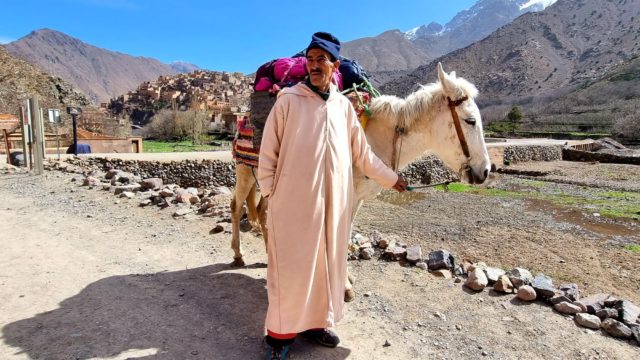
Photography by Donatas Gricius, trek up Jebel Toubkal.
High Atlas has a wide range of mountains including Jebel Toubkal, which is easily accessible and frequently visited by expert mountaineers and novice explorers.
Using photography and a few personal recommendations, let me walk you through my two day trek up Jebel Toubkal…let’s go!
Preparation for Jebel Toubkal
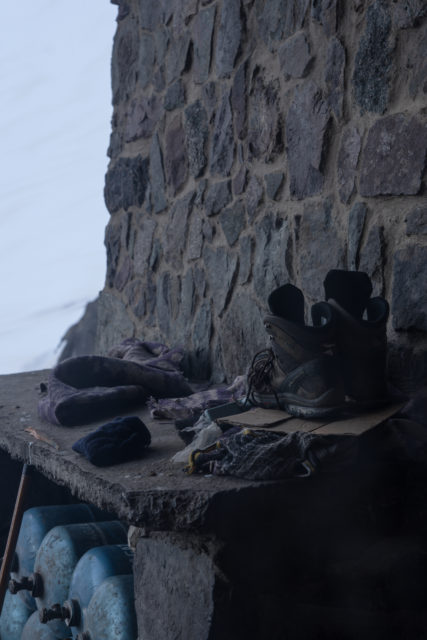
Photography by Donatas Gricius, trek up Jebel Toubkal.
As I travelled in March, I had to prepare my backpack for temperatures ranging from -10°C to 30°C.
A few weeks before my flight to Morocco, I began preparing my backpack and carrying out research about the country, Berber culture and how to summit Toubkal mountain.
The first thing I needed to pack was plenty of warm clothes for cold mornings, as well as light summer clothes for hot African days.
Must-have items include:
•Sleeping bag. It can be rented in Imlil but it’s worth having your own.
•A warm hat and gloves. These are critical items that you’ll be grateful for at 4 am on the freezing morning of the summit.
•Waterproof mountain shoes. It’s immensely important to have top quality, sturdy shoes to protect your feet from sharp rocks and water.
Finding a Jebel Toubkal guide
The best guide is the one who cares about your safety and not your money.
In Morocco, to trek this mountain it is a legal requirement to have a guide. There are many tour guides online and most of them offer similar packages. Personally, the way I found my guide was by asking 5-10 questions about the trip. The guide who responded to all my questions in detail was the one that gained my trust.
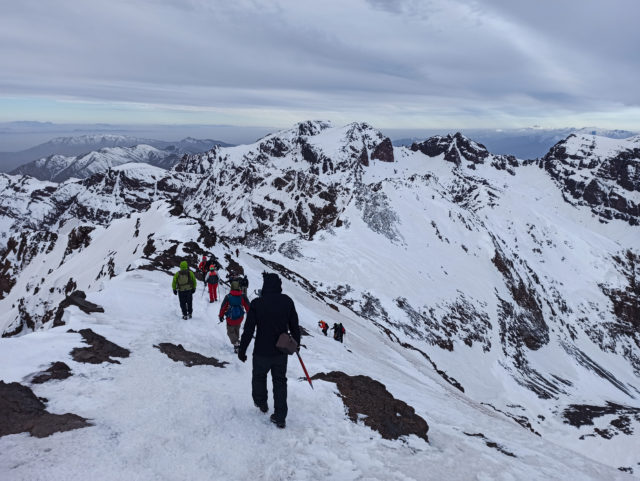
Photography by Donatas Gricius, trek up Jebel Toubkal.
Some subjects to consider asking prospective guides about:
•What should I take with me for the trek?
•A detailed plan of the trek including hours of walking to the refuge, summit, walking back to the refuge and walking back to Imlil.
•What is included in the price and what is not? Meals, mules, porters, crampons, axe, etc.
Arriving in Marrakech
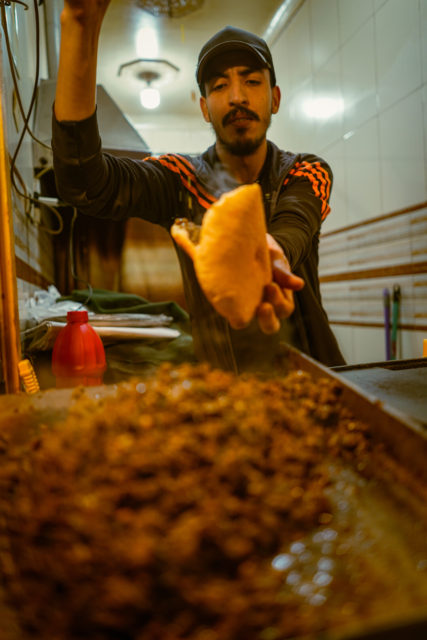
Photography by Donatas Gricius, trek up Jebel Toubkal.
Going from London straight into the Medina of Marrakech was a bit stressful and shocking. It’s a complete awakening of all the senses, as the Medina is buzzing with people and motorbikes.
The smell of kidney kebabs and slow-cooking tajine are mixed up with the sound of locals selling their goods. The Medina is a complicated labyrinth, it’s easy to get lost with an abundance of alleys always leading to another corner, filled with the likes of cotton clothes, golden lamps, leather bags or artisanal decorations.
If visiting, be aware that some locals will try to charge you money for guiding you to places, which is not always a pleasant experience as some can get aggressive. My advice is to use Google Maps and walk straight to the place where you want to reach.
Marrakech has many faces: the old buzzing Medina, welcoming Riads, quiet gardens and the European Galiz district, all of them worth exploring.
Imlil
This mountain village is approximately a 2 hour drive from Marrakech. At 1700m altitude, the landscape is a rocky mountain valley. On the way, we passed small towns where life seems unchanged from centuries before.
After many turns and twists through the mountain roads, we reached Imlil, where we arranged to meet with our guide, Mustafa. The guides there are Berbers, born in Imlil and with years of experience in taking tourists to the highest peak.
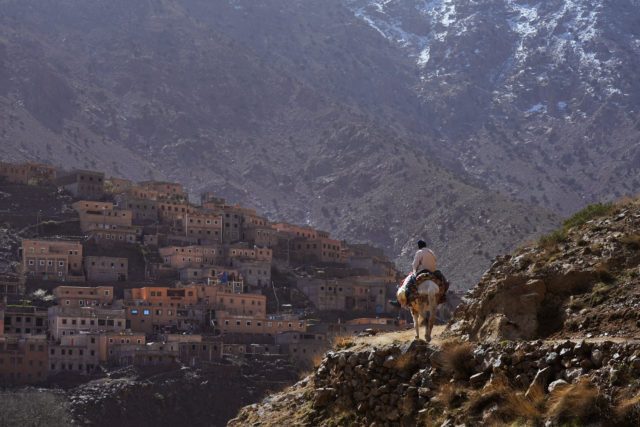
Photography by Donatas Gricius, trek up Jebel Toubkal.
Before we left for the trek, Mustafa introduced his local guide, Ibrahim. He walked with us and was responsible for ensuring our safety while doing the trek. They also made sure we had all the equipment and clothes required, and if anything was missing they offered to let us rent it. We were missing hats, warm boots, gloves and even a thermal jumper in our backpacks, but luckily they had everything for us.
Two mules carried our bags and food for the trip, which was a huge help, as the climb forward was steep.
Beginning the trek up Jebel Toubkal
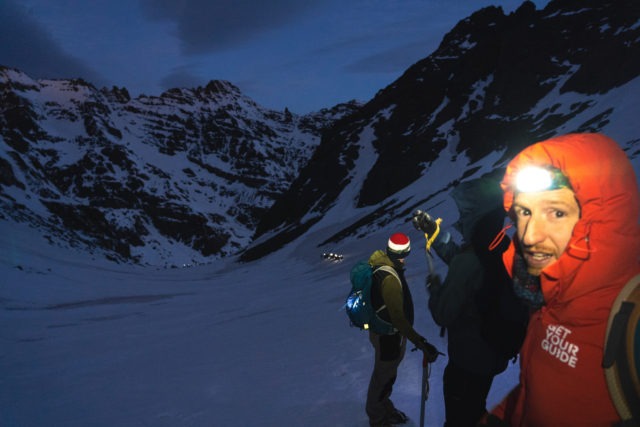
Photography by Donatas Gricius, trek up Jebel Toubkal.
During the first day, we crossed various Berber villages. It was here we’d stop for a quick mint tea or to rest for a minute before continuing.
The walk is challenging for someone who is inexperienced or not physically active, but doable with a great spirit and positive energy.
Later on in the climb, snow changed the rocky walks, the sun and blue sky remained, yet the temperature dropped.
The refuge, a place where we would be spending the night, was not yet visible. After 4 hours of walking upwards and stopping every half an hour for a minute, our legs were begging for solid ground and a warm place to rest.
Refuge – a pitstop before the summit
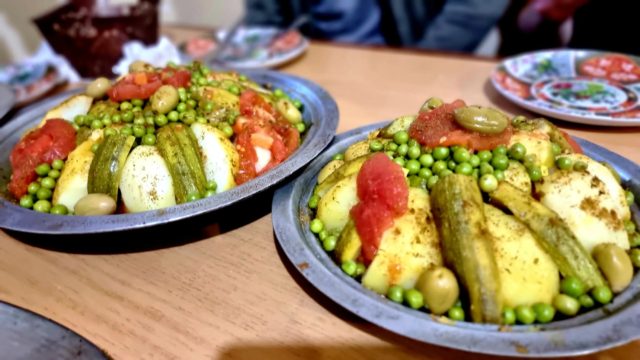
Photography by Donatas Gricius, trek up Jebel Toubkal.
Just before sunset, we reached the refuge, a place where many come to spend the night before the summit.
There are two refuge houses offering similar services: a bed, warm food, a shower and slow internet.
To recover our strength and get ready for the summit the next day, we were served a heartwarming cuscus. This is a typical dish in this region, containing boiled vegetables and lamb meat.
A warm mint tea in the remaining hours of the day invited everyone to rest for a few hours in the dormitories that hold up to 14 people. Although, we were not to expect a silent night, as many had plans to start as early as 3 am.
Reaching the refuge is itself an experience worth the effort. Some people prefer to push themselves to summit the Toubkal mountain, and some decide to start the journey back to Imlil.
The summit and a 4am start
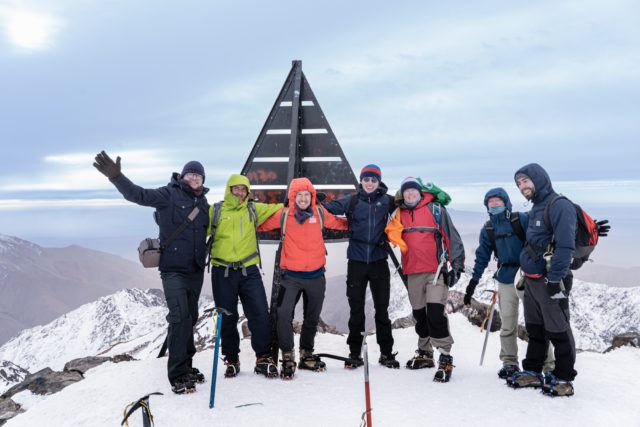
Photography by Donatas Gricius, trek up Jebel Toubkal.
It was a freezing morning but the adrenaline kept us warm, our veins flushed with warm blood as we geared up with crampons and night lights. Three hours ahead of us to climb to the top of the highest mountain in North Africa.
It was a silent walk, everyone concentrated on their steps, looking for the path that others made a moment ago. A long line of people climbed up the vertical wall, patented by a thick layer of snow.
After two hours we crossed the most challenging point in our journey, the tip of the mountain was on the horizon. We had to push ourselves one last time to ensure we would reach the finish line.
“Almost there!” some said. I lifted my head to see the triangular shape, indicating the end of the agony, our final destination, and a place that many doubt they could ever reach.
Written by Donatas Gricius



